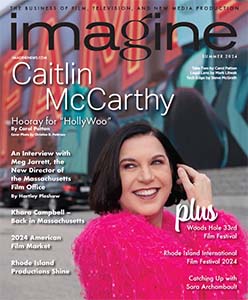AFM was outstanding this year. IMAGINE’s presence was most keenly observed and I found it gratifying to see our efforts impact such an important market. I’ve focused here on two important takeaways for filmmakers and for our country today China and Finance.
The 33rd annual American Film Market lasted for seven days. Leaders from the global film industry gathered in Santa Monica, CA buying, selling, pre-selling and financing films in every stage of development and production. The market attracted more than 7,749 attendees from more than 70 countries, screened 442 films and the AFM Conferences spoke to large audiences of more than 700 in attendance each day.

Opening Day at the American Film Market held at Loews Santa Monica Beach Resort Hotel October 31 through November 7, 2012. Photo courtesy of AFM.
I signed in and went immediately to the start of “Hong Kong Day,” a day long series of events that spotlighted the benefits of co-producing in Hong Kong, the gateway to co-producing in China. I jumped into their seminar on co-production in Hong Kong and the China market AFM Industry Conversations session featuring Zhou Tiedon, President and General Manager, China Film Promotion International and experienced panelists with great perspectives on China including Tracey Trench, a Harvard Graduate who is a consultant to Oriental DreamWorks, Jeffrey Katzenberg’s new Shanghai studio joint venture (Kung Fu Panda and its sequels interests in China), and has overseen and produced a total of thirteen feature films including THE PINK PANTHER, YOURS, MINE AND OURS, CHEAPER BY THE DOZEN and JUST MARRIED. She spoke to the Chinese question “Why is Hollywood making our stories” and the importance to China partners of looking for partners to internationalize Chinese stories.
This points to the opportunities for Westerners to find co-production deals in China, but you have to learn the ropes. Content produced in China is subject to content scrutiny and censorship as well as financial details. One panel member suggested that you not ask what you can not do in China, but what you can do in China instead. Suffice to say a script cannot be too violent, too sexy, too bloody, too political or too religious. Some producers produce two productions one for China and then dub in the script they want to make for the Western distribution.
If you are producing films for the China market someplace else it is highly recommended you include Chinese actors from China, many of them speak English. Actually, everybody in Hong Kong speaks English and that seems to be the entry point to engaging in filmmaking in China for crew, equipment, finance, travel and accommodations and it’s more comforting, again because everyone speaks English. Once you are in mainland China that will change.
It was interesting to learn that the average age of movie goers in China is 20 – 21 and that the ticket price in China is the same as that in the United States, which translates to being very expensive in China and only a small segment of the population can afford to attend once or twice a year. Video on Demand on the other hand is such a flourishing market that VOD is investing in production. This seems to be where their evolving market lies at this time. There is so much to know it’s an enormous learning curve before engaging this emerging media market of such size its difficult to imagine. Once again bridging East and West on a whole different level.
The Finance Conference, which brought leading CEOs, filmmakers, financiers and executives together to explore the state of independent film financing, emerging trends, where the money is and what the future holds.

Bullish Conference Finance Panel Tom Ortenberg, CEO Open Road Films, Nigel Sinclair, Co-Chairman and CEO, Exclusive Media and Graham Taylor, Head, Global Finance and Distribution Group, William Morris Endeavor. Photo courtesy of AFM.
The moderator and panel are people we all recognize and wish we knew better. Discussing “Current Issues in Film Finance” were moderator P. John Burke, partner, Akin Gump Strauss Hauer & Feld LLP, panelists Nigel Sinclair, Co-chairman and CEO, Exclusive Media; Tom Ortenberg, CEO, Open Road Films, and Graham Taylor, Head, Global Finance and Distribution Group, William Morris Endeavor.
The good news evoked by the entire panel is that the experts are basically bullish over equity financing and its availability at this time. Not since 2007, before the economic crisis, has equity investment become so plentiful providing production opportunity. Presales is back in fashion and now more desirable than ever as Distributors are clamoring to fill their slates to maximize and appease their buyers all around the world.
When Lehman Brothers collapsed in 2008 literally all the banks stopped lending. For fifteen months Hollywood studios made not a single acquisition. Acquisitions are now more robust, banks look like the early 90s albeit more conservative, and according to P. John Burke, a $20 to $25 million movie can conceivably reach 60 – 75% of its budget today in presales.
Add to that a generous New England State Film Tax Credit that let’s say nets out around 20 – 22%, the gap, mezzanine, private equity requirement becomes much more manageable than at any time I can remember. The conditions are favorable.
Studio and Network deals still require relationships. If you don’t have one and you are seeking a studio deal hire or partner with someone who does. It will shave years off of getting a film made. (See the Ball’s in Her Court article in this issue where Gabrielle Savage Dockterman talks about how her film got hung up in Hollywood’s self-serving red tape and how her dilemma was actually solved. You would never guess.)
Most of all it’s still all about the script. Amazing material eventually will attract everything you need to get the film made. There are some trends in cost manipulations and the monies traditionally required upfront. While the lines are blurred and theirs no set guideline, a good script these days will attract an actor who may consider deferred earnings or even take on part of the risk and become an investor in or producer of your film with earnings commensurate to profits. The rules for talent are changing. Yes, artists are now more entrepreneurial.
Another noticeable trend that benefits the industry is that ad costs are going down because of the use of social media. As digital continues to mature its impact on production, distribution and exhibition costs will be significantly less even though the demand for the product will continue to exponentially expand globally.
Here’s the big take away on Film Finance, investors from every corner of the globe want to get involved and everybody wants to be a content owner, build portfolios – take the portfolio approach. Research and go to AFM next year!
Carol Patton covers AFM every year for IMAGINE Magazine. She is its publisher and founder.





